
Prehistoric Wales in terms of human settlements covers the period from about 230,000 years ago, the date attributed to the earliest human remains found in what is now Wales, to the year AD 48 when the Roman army began a military campaign against one of the Welsh tribes. Traditionally, historians have believed that successive waves of immigrants brought different cultures into the area, largely replacing the previous inhabitants, with the last wave of immigrants being the Celts. However, studies of population genetics now suggest that this may not be true, and that immigration was on a smaller scale.
Palaeolithic
The earliest known human remains discovered in modern-day Wales date from 230,000 years ago. An early Neanderthal upper jaw fragment containing two teeth, whose owner probably lived during an interglacial period in the Lower Palaeolithic, was found in a cave in the River Elwy valley, at the Bontnewydd Palaeolithic site, near St Asaph (Welsh: Llanelwy), Denbighshire.[1][2] Excavations of the site between 1978 and 1995 revealed a further 17 teeth belonging to five individuals, a total of seven hand axes and some animal bones, some of which show signs of butchery.[3] This site is the most north-westerly in Eurasia at which the remains of early hominids have been found, and is considered to be of international importance. Late Neanderthal hand axes were also found at Coygan Cave, Carmarthenshire and have been dated to between 60,000 and 35,000 years old.[4][5]
The Paviland limestone caves of the Gower Peninsula in south Wales are by far the richest source of Aurignacian material in Britain, including burins and scrapers dated to about 28,500 years ago.[6] The first remains of modern humans, Homo sapiens sapiens, to be found in Wales was the famous Red Lady of Paviland, discovered in the 1820s. This was a human skeleton dyed in red ochre discovered in 1823 in one of the Paviland caves in Gower.[7] Despite the name, the skeleton is actually that of a young man who lived about 33,000-34,000 years ago,[8] coincident with a warmer period at the end of the Upper Paleolithic Period (Old Stone Age).[9] He is considered to be the oldest known ceremonial burial in Western Europe.[10] The skeleton was found along with fragments of small cylindrical ivory rods, fragments of ivory bracelets and seashells.[11] Settlement in Wales was apparently intermittent, as periods of cooling and warming led to the ice sheets advancing and retreating. Wales appears to have been abandoned from about 21,000 years ago until after 13,000 years ago, with a burial found at Kendrick's Cave on the Great Orme dating to about 12,000 years ago.[12]
Mesolithic
Following the last Ice age, Wales became roughly the shape it is today by about 7000 BC and was inhabited by Mesolithic hunter-gatherers. Wales has many sites where Mesolithic material has been found, but securely stratified material is rare.[13] The earliest dated Mesolithic site in Wales is Nab Head, Pembrokeshire, around 9,200 years ago.[14] Many of the sites from this period are coastal, although 9,000 years ago they would have been some distance inland from the sea. There is a particular concentration in Pembrokeshire, but there are also a good number of upland sites, most apparently seasonal hunting locations, for example around Llyn Brenig.[15] Some decorated pebbles found at Rhuddlan represent the earliest art found in Wales.[16]
Anglesey's permanent settlement has a history beginning c. 9,000 years ago during the Mesolithic (European) period at the Aberffraw bay, Trwyn Du (Welsh: Black nose) excavated site. Millenniums later, around 2,000 BC was when a Bronze Age kerb cairn (bowl barrow) was built covering the original Trwyn Du artifact deposit of 7,000 thousand Mesolithic flint tools and 2 axes.[17][18][19][20]
Neolithic
The earliest farming communities are now believed to date from about 4000 BC, marking the beginning of the Neolithic period. Pollen evidence indicates the clearing of forests on an increasing scale during this period. The Neolithic saw the construction of many chambered tombs, the most notable including Bryn Celli Ddu and Barclodiad y Gawres on Anglesey.[21] Also on the isle is one of the earliest settlements in Wales (potentially Wales' first village). The wooden long houses near Llanfaethlu is the remains of a Neolithic village dated to 4,000 BC. Flint tools were also found at the site.[22]
Three main types of megalithic tomb are found in Wales, the Severn-Cotswold type in the south-east, the Portal dolmen type and the Passage graves which are characteristic of the Irish Sea area and the Atlantic façade of Europe and Morocco. Megalithic tombs are most common in the western lowlands.[23] There is evidence of close cultural links with Ireland, particularly in the Early Neolithic period.[24]
A number of houses from the Neolithic period have also been found in Wales, most notably the settlement at Clegyr Boia near St David's in Pembrokeshire. Many artefacts have also been found, particularly polished stone axeheads. There were a number of "factories" in Wales producing these axeheads, the largest being the Graig Lwyd factory at Penmaenmawr on the north coast which exported its products as far afield as Yorkshire and the English midlands.[25] Pottery finds also indicate a relationship with Ireland.
 Bryn Celli Ddu 'Pattern Stone' (replica)
Bryn Celli Ddu 'Pattern Stone' (replica)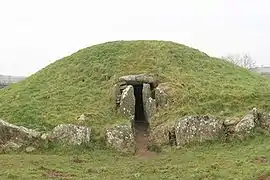
 Siambr gladdu Oes y Cerrig, dolmen, c. 3000 BC.[27]
Siambr gladdu Oes y Cerrig, dolmen, c. 3000 BC.[27] Maen Ceti (arthur stone) burial site, Gower
Maen Ceti (arthur stone) burial site, Gower Bryn Gwyn stones
Bryn Gwyn stones The Maesmor mace-head, c. 3000-2500 BC.[28]
The Maesmor mace-head, c. 3000-2500 BC.[28]
The Bronze Age

Metal tools first appeared in Wales about 2500 BC with the Bell Beaker culture, initially copper followed by bronze. The climate during the Early Bronze Age (c. 2100-1400 BC) is thought to have been warmer than at present, as there are many remains from this period in what are now bleak uplands. Much of the copper for the production of bronze probably came from the copper mine on the Great Orme, where prehistoric mining on a very large scale dates largely from the middle Bronze Age.[29] In particular copper from the Great Orme mines appears to have been used for the production of bronze implements of the Acton Park Complex, named after a hoard found at Acton Park near Wrexham. These tools, particularly axeheads, were developed towards the end of the Early Bronze Age and are innovative in both metallurgy and design. They were widely exported, with examples being found along the continental coast from Brittany to north Germany.[30]
Burial practices in the Bronze Age differed from the communal tombs of the Neolithic period, with a change to burial in round barrows and the provision of grave goods. Inhumation was soon replaced by cremation and in Wales the cemetery mound with a number of burials had become the standard form by about 2000 BC.[31] One of the most striking finds from Bronze Age Wales was the gold cape found in a tomb at Bryn yr Ellyllion, Mold, Flintshire dated to 1900-1600 BC, weighing 560 g and produced from a single gold ingot. Very few weapons have been found in Early Bronze Age graves in Wales compared with other objects, and the lack of traces of earlier Bronze Age settlements is thought to indicate that farms or hamlets were undefended.[32]
From about 1250 BC there was a deterioration in the climate which became more marked from about 1000 BC, with higher rainfall and much lower summer temperatures. This led to an increase in peat formation and probably the abandonment of many upland settlements.[33] It has been suggested that this led to conflict and to changes in social organization, with the earliest hillforts appearing about 800 BC.[34]
The Late Bronze Age saw the development of more advanced bronze implements, with weapons becoming increasingly common.[35] While the weapons reflect introduced styles, there are pronounced regional variations in the styles of tools, particularly axes. On the basis of tool types, Wales can be divided into four regions, These were, the Ordovices (Mid to North Wales & Anglesey), the Deceangli (North East Wales), the Demetae (South West Wales), and the Silures (South East Wales). These regions show an approximate correspondence to the territories of the tribes later recorded in these areas by the Romans.[36]
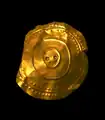
.jpg.webp) Gold lunula, Bell Beaker culture, 2400-2000 BC
Gold lunula, Bell Beaker culture, 2400-2000 BC The Mold Cape, c. 1900-1700 BC
The Mold Cape, c. 1900-1700 BC The Caergwrle Bowl, c. 1300 BC
The Caergwrle Bowl, c. 1300 BC.png.webp) Gold ornament
Gold ornament_(FindID_519052).jpg.webp) Bronze rapier sword
Bronze rapier sword.jpg.webp) Bronze socketed axes
Bronze socketed axes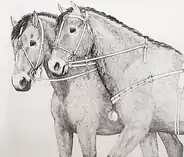 Horse harness
Horse harness
The Iron Age

The earliest iron implements found in Wales come from Llyn Fawr at the head of the Rhondda Valley, where objects apparently deposited as votive offerings include three made of iron: a sword, a spearhead and a sickle. These items are thought to date to about 650 BC, and while the sword appears to be imported, the sickle is an imitation of a native bronze prototype.[39]
Over 600 hillfort were built in Wales and throughout the British Isles from c. 800 BC.[18] The Iron Age saw the building of hillforts which are particularly numerous in Wales, including Pen Dinas near Aberystwyth and Tre'r Ceiri on the Llŷn Peninsula. The earliest distinctively Iron Age settlement in Wales is considered to be Castell Odo (modern-day Aberdaron), a small hillfort on the tip of the Llŷn Peninsula, the fort dates to about 400 BC but was actually settled during the late Bronze Age. The largest hillforts are most numerous along the eastern border of Wales, with some large examples also found in the lowlands of north-west Wales. In the south-west, by contrast, hillforts are very numerous but mainly small, with an area of under 1.2 hectares.[40][41] An example on Anglesey is Arthur's Table (Welsh: Bwrdd Arthur / Din Sylwy) hillfort, it's an Iron Age settlement that was inhabited for a millennium until after the Roman period (c. 4 AD).[18][42][43][44]

Some Celtic tribes originated in Germany and migrated throughout Western Europe, also to Britain and Ireland. These western European Iron Age tribes in Britain were established in the late Iron Age between c. 500 BC - 200 BC. Later in the Iron Age, stone roundhouses were being built from c. 500 BC (earliest). Hut circles were found throughout Wales and Celtic Europe. These stone-built roundhouses were occupied for nearly a thousand years and were used until the end of the Roman occupation of Great Britain during the 5th century. A well-preserved hut circle on Anglesey is Din Lligwy, the small village was dated from the Iron Age to Roman occupation. A hoard of Roman era pottery and coins were discovered in the 1905-07 archaeological excavation of Din Lligwy.[46][45][47][48]
A particularly significant find from this period was made in 1943 at Llyn Cerrig Bach on Anglesey, when the ground was being prepared for the construction of a Royal Air Force base. The cache included weapons, shields, chariots along with their fittings and harnesses, and slave chains and tools. Many had been deliberately broken and seem to have been votive offerings.[49] These finds are considered to be one of the most important collections of La Tène metalwork discovered in Britain. Pottery on the other hand is fairly rare in Wales during this period and most of what has been found appears to be imported.[50]
The La Tène culture is traditionally associated with the Celts, and the general view until fairly recently was that the appearance of this culture indicated a large-scale invasion by peoples who also brought a Celtic language which later developed into Welsh.[51] The currently more popular view is that any movement of peoples was on a smaller scale, with cultural diffusion responsible for most of the changes. There is some evidence to support the latter model, such as burials associated with earlier religious sites.[52] It has been suggested that a Celtic language was being spoken in Wales by about 700 BC.
The prehistoric period ended with the arrival of the Roman army, who began their campaigns against the Welsh tribes in 48 AD with an attack on the Deceangli in north-east Wales. Wales was divided between a number of tribes, of which the Silures and the Ordovices put up the most stubborn resistance. The Roman conquest of Wales was complete by 79 AD. The reports of Roman historians such as Tacitus give a little more information about Wales in this period, such as that the island of Anglesey was apparently a stronghold of the Druids. The impact of the arrival of the Romans may have varied from one part of Wales to another; for example there is evidence that some hillforts, such as Tre'r Ceiri, continued to be occupied during the Roman period.
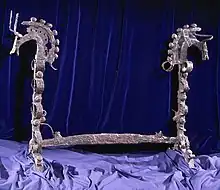
_(FindID_599015).jpg.webp) Copper alloy fob with triskele design
Copper alloy fob with triskele design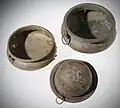 Bronze bowls and wine strainer with triskele design from Langstone, Newport.[54]
Bronze bowls and wine strainer with triskele design from Langstone, Newport.[54].jpg.webp)

 Reconstruction of an Iron Age roundhouse at Melin Llynon, Anglesey
Reconstruction of an Iron Age roundhouse at Melin Llynon, Anglesey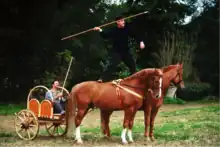 Reconstruction of an Iron Age chariot.[56]
Reconstruction of an Iron Age chariot.[56] Remains of dry-stone fortifications at Tre'r Ceiri hillfort, Gwynedd
Remains of dry-stone fortifications at Tre'r Ceiri hillfort, Gwynedd
Notes
| History of Wales |
|---|
 |
- ↑ Lynch 2000, p. 6.
- ↑ People's Collection a.
- ↑ People's Collection b.
- ↑ People's Collection c.
- ↑ People's Collection d.
- ↑ Lynch 2000, p. 16.
- ↑ Whittle 1992, p. 4.
- ↑ Jacobi & Higham 2008, pp. 898–907.
- ↑ Richards & Trinkaus 2009, pp. 16034–9.
- ↑ Oxford Museum of Natural History.
- ↑ Lynch 2000, pp. 18–19.
- ↑ Lynch 2000, p. 41.
- ↑ Lynch 2000, p. 39.
- ↑ Lynch 2000, p. 23.
- ↑ Lynch 2000, p. 312.
- ↑ Lynch 2000, p. 38.
- ↑ "Scheduled Monuments- Full Report". cadwpublilc-api.azurewebsites.net. Retrieved 29 August 2023.
- 1 2 3 "Prehistoric Wales". cadw.gov.wales. Retrieved 28 August 2023.
- ↑ "Trwyn Du Cairn near Aberffraw, Overlying A Mesolithic Site (302323)". Coflein. RCAHMW.
- ↑ "Aberffraw to port Cwyfan, Anglesey" (PDF). walescostalpath.gov.uk.
- ↑ Lynch 2000, pp. 34–42, 58.
- ↑ "Wales' earliest village?". archaeology.co.uk. 5 October 2017.
- ↑ Lynch 2000, p. 42-43.
- ↑ Lynch 2000, p. 54.
- ↑ Lynch 2000, p. 56-57.
- ↑ "Bryn Cello Ddu". cadw.gov.wales. Retrieved 23 October 2023.
- ↑ "Siambr Gladdu Tŷ Newydd". cadw.llyw.cymru. Retrieved 23 October 2023.
- ↑ "A Stone Age masterpiece - A Mace-head from North Wales". National Museum of Wales.
- ↑ Lynch 1995, pp. 39–40.
- ↑ Lynch 2000, p. 99.
- ↑ Lynch 2000, p. 126.
- ↑ Lynch 2000, p. 138.
- ↑ Lynch 2000, pp. 140–145.
- ↑ Lynch 2000, p. 150.
- ↑ Lynch 2000, p. 180.
- ↑ Lynch 2000, p. 184.
- ↑ "Early Bronze Age gold disc". National Museum Wales.
- ↑ "Copper mining, prospection and the Beaker Phenomenon in Wales – The significance of the Banc Tynddol gold disc". 2016.
- ↑ Cunliffe 1978, p. 290.
- ↑ "Early Celtic Societies in North Wales project – Excavations at Meillionydd 2010". Prifysgol Bangor University. 2010. Archived from the original on 20 December 2016. Retrieved 2 September 2023.
- ↑ Lynch 2000, p. 147.
- ↑ "Din Sylwy or Bwrdd Arthur (93842)". Coflein. RCAHMW.
- ↑ Smith, George, ed. (2018). "Iron Age Settlement in Wales". Internet Archaeology. 48 (Hillforts and Hut Groups of North-West Wales). doi:10.11141/ia.48.6.
- ↑ Foster & Daniel 2014, p. 130.
- 1 2 "Din Lligwy Hut Group". cadw.gov.wales. Retrieved 29 August 2023.
- ↑ RCAHMW, An Inventory of the Ancient Monuments in Anglesey, p. LXXX, at Google Books
- ↑ "The Celts in Wales". sarahwoodbury.com. 5 June 2019. Retrieved 29 August 2023.
- ↑ Koch, Thomas (2005). Celtic Culture: a Historical Encyclopedia. ABC-Clio. p. 945. ISBN 1851094407.
- ↑ Lynch 1991, p. 249-77.
- ↑ Lynch 2000, p. 199.
- ↑ Cunliffe 1978, p. 3.
- ↑ Lynch 2000, p. 213.
- ↑ "The Capel Garmon Firedog". National Museum of Wales.
- ↑ "The Langstone treasure". National Museum of Wales.
- ↑ "The Penbryn Spoons". British Archaeology at the Ashmolean Museum.
- ↑ "Iron Age chariot". National Museum of Wales.
See also
Bibliography
- Cunliffe, Barry W. (1978). Iron age communities in Britain : an account of England, Scotland, and Wales from the seventh century BC until the Roman conquest (2d ed.). London: Routledge & Kegan Paul. ISBN 071008725X.
- Davies, John (1994). A history of Wales. London: Penguin Books. ISBN 0-14-014581-8.
- Foster, I.Ll.; Daniel, Glyn (24 October 2014). Prehistoric and Early Wales (1st ed.). London: Routledge.
- Jacobi, R.M.; Higham, T.F.G. (November 2008). "The "Red Lady" ages gracefully: new ultrafiltration AMS determinations from Paviland". Journal of Human Evolution. 55 (5): 898–907. doi:10.1016/j.jhevol.2008.08.007. PMID 18929395.
- Lloyd, John Edward (1911). A History of Wales: From the Norman Invasion to the Edwardian Conquest. Barnes & Noble Publishing. ISBN 978-0-7607-5241-8.
- Lynch, Frances (1995). Gwynedd. London: H.M.S.O. ISBN 0-11-701574-1.
- Lynch, F. M. (1991). Prehistoric Anglesey : the archaeology of the island to the Roman conquest (2nd ed.). Llangefni: Anglesey Antiquarian Society. ISBN 0950019976.
- Lynch, Frances (2000). Prehistoric Wales. Stroud [England]: Sutton Pub. ISBN 0-7509-2165-X.
- "The 'Red Lady' of Paviland". oumnh.ox.ac.uk. Oxford University. Retrieved 29 March 2023.
- "Upper jaw of a Neanderthal child aged around 8 years old". Peoples Collection Wales. Retrieved 29 March 2023.
- "The oldest people in Wales - Neanderthal teeth from Pontnewydd Cave". Peoples Collection Wales. Retrieved 29 March 2023.
- "Coygan Cave (Carmarthenshire). No human remains have been found here, just a handful of tools that show that Neanderthals used the cave briefly". Peoples Collection Wales. Retrieved 29 March 2023.
- "The Cave Men of Ice Age Wales". Peoples Collection Wales. Retrieved 29 March 2023.
- Pitts, M (2006). "Sensational new discoveries at Bryn Celli Ddu". British Archaeology. 89: 6.
- Richards, MP; Trinkaus, E (September 2009). "Out of Africa: modern human origins special feature: isotopic evidence for the diets of European Neanderthals and early modern humans". Proc. Natl. Acad. Sci. U.S.A. 106 (38): 16034–9. Bibcode:2009PNAS..10616034R. doi:10.1073/pnas.0903821106. PMC 2752538. PMID 19706482.
- Taylor, J. A. (1980). Culture and environment in prehistoric Wales : selected essays. Oxford, Eng.: B.A.R. ISBN 0-86054-079-0.
- Whittle, Elisabeth (1992). A guide to ancient and historical Wales. Glamorgan and Gwent. London: HMSO. ISBN 0117012211.
External links
 Media related to Prehistoric Wales at Wikimedia Commons
Media related to Prehistoric Wales at Wikimedia Commons- Royal Commission on the Ancient and Historical Monuments of Wales
- Artifacts from Pontnewydd Cave held on Gathering the Jewels
- Artifacts from Coygan Cave held on Gathering the Jewels
- Artifacts from Paviland Cave held on Gathering the Jewels
- Mesolithic stone beads from Nabs Head, Pembrokeshire, held on Gathering the Jewels
- Mesolithic fins from Rhuddlan held on Gathering the Jewels
- Pentre Ifan Cromlech/Dolmen in Pembrokeshire, Wales
- Carreg Coetan Arthur Cromlech/Dolmen in Pembrokeshire, Wales
- The Prehistoric Monuments in Wales, Herbert E. Roese

.jpg.webp)
